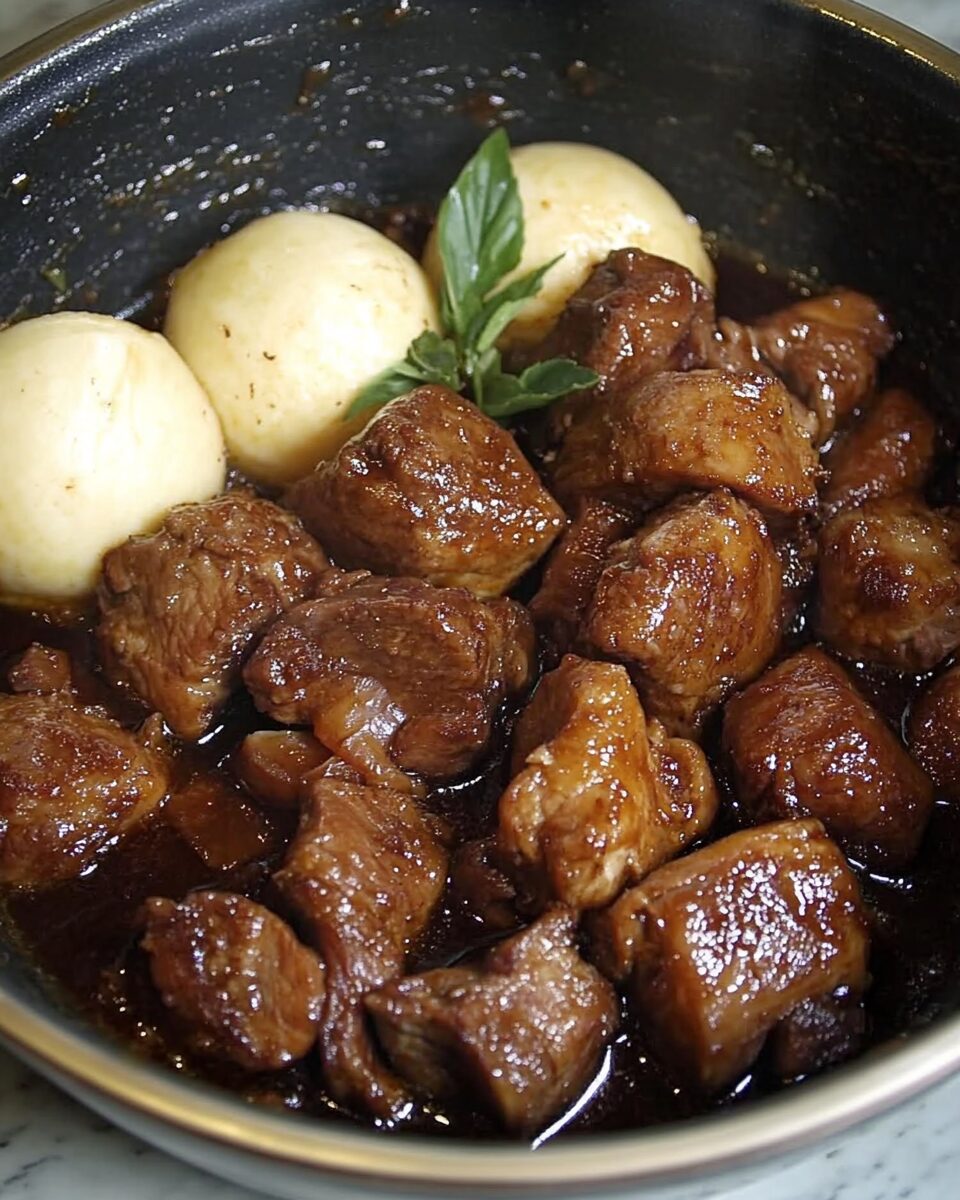Pork and Chicken Adobo is a classic Filipino dish known for its rich, savory, and slightly tangy flavor. It is made by braising pork and chicken in a flavorful mixture of soy sauce, vinegar, garlic, bay leaves, and black peppercorns. This dish is a staple in Filipino households, often served with steamed rice to soak up the delicious sauce. The combination of pork and chicken creates a perfect balance of textures and flavors, making it a comforting and satisfying meal.
Full Recipe:
Ingredients
- Chicken, cut into pieces
- Pork belly, cut into chunks
- Soy sauce
- Vinegar
- Garlic, minced
- Bay leaves
- Black peppercorns
- Onion, sliced
- Sugar (optional)
- Water or broth
- Cooking oil
Directions
- In a bowl, marinate the chicken and pork in soy sauce, garlic, and black pepper for at least 30 minutes.
- Heat oil in a pan and sauté onions until soft.
- Add the marinated meat, browning it on all sides.
- Pour in vinegar, bay leaves, and water or broth, bringing it to a simmer.
- Cover and let it cook until the meat is tender and the sauce has thickened.
- Adjust seasoning as needed and serve with steamed rice.
Nutritional Facts
- Calories: 420 per serving
- Protein: 35g
- Carbohydrates: 6g
- Fat: 28g
- Saturated Fat: 8g
- Cholesterol: 120mg
- Sodium: 900mg
- Fiber: 1g
- Sugar: 1g
The Origins of Adobo
Adobo is widely regarded as the national dish of the Philippines, cherished for its rich, savory, and slightly tangy flavors. The term “adobo” comes from the Spanish word adobar, meaning “to marinate” or “to season.” However, Filipino adobo is distinctly different from its Spanish counterpart. The dish predates Spanish colonization, with indigenous Filipinos using vinegar and salt to preserve meat in the tropical climate. When the Spanish arrived in the 16th century, they named the dish “adobo” because of its marinated preparation, but the technique had already been part of Filipino cooking for centuries.
Over time, soy sauce replaced salt as the primary seasoning, influenced by trade with Chinese merchants. This led to the modern version of adobo, which is now one of the most beloved and recognizable Filipino dishes worldwide.
Why Pork and Chicken Adobo is Special
Pork and Chicken Adobo is unique because it combines two types of meat, each contributing different textures and flavors. The chicken becomes tender and juicy as it absorbs the sauce, while the pork—often using fatty cuts like pork belly—adds richness and depth. The combination of these meats results in a hearty dish with a perfect balance of flavors.
What makes adobo truly special is its versatility. The base ingredients—soy sauce, vinegar, garlic, bay leaves, and peppercorns—remain consistent, but variations exist depending on region and personal preference. Some versions are saltier, while others have a slightly sweet or spicier profile. The beauty of adobo lies in its adaptability, making it an easy yet deeply flavorful dish to prepare.
The Signature Flavor of Adobo
Pork and Chicken Adobo is known for its distinct balance of flavors:
- Savory and umami: The soy sauce provides depth, richness, and saltiness.
- Tangy and bright: Vinegar adds a sharpness that cuts through the richness, giving adobo its signature taste.
- Aromatic and earthy: Garlic, bay leaves, and black peppercorns infuse the dish with layers of complexity.
- Slightly sweet (optional): Some variations incorporate sugar or coconut milk for a hint of sweetness.
The slow simmering process allows the meat to absorb these flavors fully, creating a dish that is even better the next day as the sauce continues to develop.
Regional Variations of Adobo
While the classic soy sauce and vinegar adobo is the most well-known version, there are many regional variations across the Philippines:
- Adobo sa Gata: A version from the Bicol region that adds coconut milk for a creamy, slightly sweet, and rich flavor.
- Adobo sa Dilaw: A Batangas-style adobo that uses turmeric instead of soy sauce, giving it a golden color and a milder taste.
- Adobong Puti: The “white” version of adobo, which omits soy sauce and relies purely on vinegar and garlic for seasoning.
- Adobo with Pineapple: A sweeter variation that includes pineapple chunks, popular in some provinces for its contrast of sweet and tangy flavors.
- Spicy Adobo: Some regions prefer adding chili peppers to give the dish a kick of heat.
These variations showcase how adaptable and personal adobo can be, with each household having its own signature recipe.
The Role of Adobo in Filipino Culture
Adobo is more than just a meal; it is a cultural symbol of Filipino identity. It is a dish that brings families together, often prepared for gatherings, fiestas, and everyday meals. Its simplicity and affordability make it accessible to all, while its deep flavors make it a favorite among Filipinos and foreigners alike.
Adobo is also a popular “baon” (packed meal) because its vinegar-based sauce acts as a natural preservative, keeping it fresh for long periods without refrigeration. This makes it ideal for students, workers, and travelers who need a hearty, home-cooked meal on the go.
Health Benefits of Pork and Chicken Adobo
While Pork and Chicken Adobo is known for its rich flavors, it also offers several health benefits:
- High in Protein: Chicken and pork provide essential proteins that help with muscle growth and repair.
- Low in Carbohydrates: This dish is naturally low in carbs, making it suitable for keto and low-carb diets.
- Rich in Antioxidants: Garlic and black pepper contain antioxidants that help boost the immune system.
- Good for Gut Health: Vinegar promotes healthy digestion and contains probiotics that support gut health.
- Iron and B Vitamins: Pork, particularly cuts like pork belly, provides iron and B vitamins that support energy production and brain function.
To make adobo healthier, some people reduce the oil and fat content by using leaner cuts of meat or trimming excess fat. Others substitute soy sauce with low-sodium alternatives to manage salt intake.
Best Ways to Serve Pork and Chicken Adobo
Adobo is traditionally served with steamed white rice, which soaks up the flavorful sauce. However, there are several creative ways to enjoy this dish:
- With Garlic Rice: Frying leftover rice with garlic enhances the flavors and makes for a satisfying meal.
- Over Noodles: Adobo can be served over pancit (Filipino noodles) for a unique twist.
- As an Adobo Flakes Dish: Shredded leftover adobo is pan-fried until crispy and served with eggs for breakfast.
- With Roasted Vegetables: Pairing adobo with roasted eggplant, okra, or string beans adds a nutritious balance.
- As a Sandwich Filling: Some people enjoy adobo in a sandwich, similar to pulled pork, for a Filipino-style adobo sandwich.
Pairing Adobo with Drinks
To enhance the flavors of adobo, consider pairing it with complementary beverages:
- Beer: A cold lager or pale ale balances the salty and tangy notes of adobo.
- Red Wine: A medium-bodied wine like Merlot or Zinfandel complements the richness of the pork.
- Calamansi Juice: This Filipino citrus drink adds a refreshing contrast to the dish.
- Iced Tea: A slightly sweet iced tea helps mellow the acidity of the vinegar.
Why You Should Try Pork and Chicken Adobo
If you have never tried adobo before, this is the perfect dish to start with. It is easy to prepare, requires minimal ingredients, and delivers a complex yet comforting flavor. Whether you prefer it salty, tangy, sweet, or spicy, you can adjust the seasonings to suit your taste. Additionally, adobo is an excellent make-ahead meal, as it tastes even better the next day. The longer the meat sits in the sauce, the more the flavors meld together, making leftovers even more delicious.
Conclusion
Pork and Chicken Adobo is more than just a Filipino dish; it is a reflection of the country’s rich culinary heritage. Its simple yet bold flavors, adaptability, and cultural significance make it a dish that stands the test of time.






